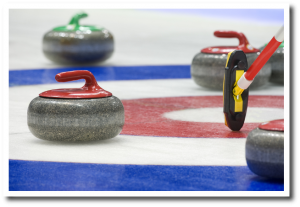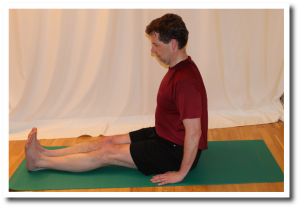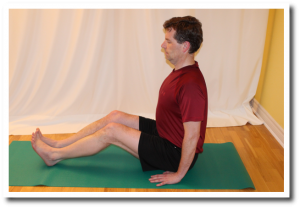Bob has been watching a lot of TV lately. The Curling Finals are on and he has not been paying attention to his posture while he watches. He has been letting his back round and his chest drop down towards his hips. Not only is it poor posture his lower back is starting to hurt.
Dandasana is a very simple yoga pose that can help Bob to improve his posture and protect his lower back at the same time.
What is Dandasana
Dandasana is a seated pose that you come to before and after you perform another seated pose. Dandasana pronounced dahn-DAH-sah-nah is the Sanskrit name of the pose. The common English name for this pose is Staff pose. The pose looks like two staffs. One laying on the ground and the other rising straight up out of the ground.
Dandasana is a relatively simple pose to do that helps to improve your posture, strengthens your back muscles as well as stretching your back and shoulder muscles.
How to do Dandasana
To get started you sit on your mat with your legs together and straight out in front of you.
Next you move the top of your hips above your sitz bones and straighten your back as you lift your torso up.
Now let your arms descend straight down from your shoulders and rest your hands on the floor beside your hips.
Finally draw your shoulder blades back towards your spine and down towards your hips as you lift your chin and gaze to the horizon.
Hold here for several breaths before you move on to your next pose.
One of the challenges when you are working on setting up for this pose is short hamstrings and the affect it has on your lower back.
How do Short Hamstrings affect Dandasana
When you tip your hips up to the vertical while at the same time drawing your feet back towards your torso you may notice your hamstrings complaining.
Your hamstrings are attached part way up the back of your hips and just beyond your knees on your shins. When you straighten your hips and draw your toes back towards you, you are asking your hamstrings to lengthen a lot more than they usually do.
Your short hamstrings also affect your lower back. With your hips tipped back your lower back is rounded and this causes stress, fatigue and pain to your lower back. With a rounded back your posture is poor, your chest is dropped into your abdomen and your organs are getting compressed.
Our hamstrings get short because of our lifestyle. We spend a lot of time sitting down. We sit down to eat, we sit down to watch TV, we sit down to work, and we sit down when we drive to work. All of this sitting down lets our hamstrings get shorter and shorter.
Bob can use the Bent Pin technique to accommodate his short hamstrings and start to lengthen them back out.
How to do the Bent Pin technique
The Bent Pin technique is simple to implement. Bend your knees upwards and draw your heels back towards your hips. Keep your knees together as you lift them up and keep your toes drawn back towards your hips.
As you lift your knees up you will notice that the pressure on your hamstrings lessens. Now you will be able to get the back of your hips straight up and down when you draw your toes back towards your hips.
To get the maximum benefit from the bent pin technique you need to use your edge.
Once you get the Bent Pin technique in place pay attention to the sensation in your hamstrings. You want the sensation to be comfortable and challenging. This is your edge.
Use your edge
You adjust the sensation in your hamstrings by gradually moving your heels away from or back towards your hips. The stretching sensation in your hamstrings will increase as you move your feet away from your hips. You want to increase the sensation to the point where it is still comfortable but it is also challenging. You feel like even though it is challenging you can stay here for an extended period of time.
You want to stay away from the stretching sensation where you are afraid that you will injure your muscles. This is the place that you can not wait for it to be over.
Finding and using your edge will stretch your hamstrings safely and avoid injury to them.
Stretching your hamstrings will eventually remove the need to use the Bent Pin technique and it will also protect other areas of your body.
Why do the Bent Pin technique
Use the Bent Pin technique to protect your lower back from injury.
Pulling your hips back and down towards the mat causes your lower back to round. Rounding your lower back removes the natural curve, causes you to slouch and compresses your abdominal organs. Rounding your lower back also stresses and fatigues those muscles leading to lower back pain.
Implementing the Bent Pin technique relives this pressure on your lower back. It protects the muscles in your lower back and allows you to have better posture as you sit taller with your hips rising straight out of the floor.
Summary
The Bent Pin technique gives Bob a tool that he can use to safely stretch his hamstrings and protect them and his lower back from injury. Once Bob gets used to the good posture that Dandasana develops maybe next time he is watching the Curling Finals on TV he will protect his lower back a little better.
Utilizing your Edge with this technique will protect you from injuring your hamstrings while you are stretching them out to their former length.
Next Step
Ask your yoga teacher to help you with the implementation of the Bent Pin Technique.
Additional Reading
To learn more about your Edge read the article How to use the Steam Engine to find your Edge.
Following the advice in How the Tree Trunk method improves your Dandasana you will protect your back.
Read How to build your goal posts in Dandasana to learn about getting your arms in the right place.






